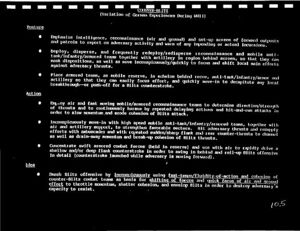Patterns of Conflict
| The works of |
| Works of John Boyd |
|---|
OODA WIKI Edition
Quantico Transcription
So I’ll let you read this and then I’ll comment on it, see what’s going on here.
You see, now since we’ve built up a repertoire, now we can go through and exploit the ideas
we’ve built up along the way. That’s what I’m doing now. We can move more rapidly for exploiting.
[long pause as audience reads slide]
Let’s go to the posture. First of all, you want to depend upon your intelligence, your reconnaissance, et cetera. In other words, you’re trying to get as much information from many different sources about your enemy.
Then set yourself up in depth. First screen behind there, you want this one, behind that, this one.
You want to set yourself up in depth so you can adjust to the circumstance. And note this, deploy, disperse, freely redeploy and re-disperse. Why do you want to redeploy and re-disperse? Anybody?
Audience: Keep them off balance.
Boyd: Because if you keep your units the same thing, they’re going to know. You’re going to become predictable. So you want to keep changing it, so you give the guy a real— he can’t figure out what’s going on. In other words, you want to build up his uncertainty so he can’t cope with what’s going on. That’s what you’re trying to do.
At the same time, when you do that, though, you want to set up such that you can still easily focus your own main efforts to dig into those thrusts when they’re coming into you, preferably from a flank or rear, not head on.
Have reserves. Why do you want strong reserves? I can give you three reasons, two of which Clausewitz had. One, reserves are used for what? To deal with uncertainty, unforeseen events.
You don’t know exactly what’s going to happen, so it gives you a base for dealing with something unpredictable. To adjust to unforeseen events, that’s the reserves. That’s one reason.
Two, to sustain or prolong operations. Without reserves, you’re going to wear your people out.
And that’s why you want to reconstitute reserves all the time.
And there’s a third reason. Clausewitz had two of them, but there’s a third reason. Can anybody guess what the third one is?
Audience: To support that area where you would penetrate the weakness.
Boyd: Yeah, that’s all right, but I’m going to give a more fundamental reason, a sort of higher-level reason. That’s all right. Anybody want to try?
Audience: To exploit success.
Boyd: Yeah, you’re sort of right, but what I’m trying to say is, your adversary doesn’t know how you’re going to use the reserves, so you generate uncertainty in his mind too. Remember, you use the reserves in order to generate uncertainty that is relative to him, also to prolong operations.
Since he doesn’t know exactly how you’re going to use your reserves, you build up uncertainty in his mind too. So three reasons. For you to deal with it, also to build it up in him. Because it allows, it’s very important.
When you look at the German operation, you talk about it all the time. And then, of course, your action. Don’t get put in the bag. Start using your screening assets, your recce assets to find out what the hell’s going on. You get a picture of what’s going on. And then you can start moving your troops into those regions, so you can start hitting them from the local flanks and the rear, start digging into them.
But if they have a lot of forces going through, they’re still going to blow through. And that’s why you’ve got the reserves back here. So then you can have an arching swift counterstroke and really cut them up, roll them up in the flank and rear.
In other words, you’ve got multiple thrusts going into them like they’re coming into you. So you’re building up their problem also. Then the idea is very simple.
So what are you really doing here? Think about it. What are you really doing here?
Audience: Conducting your own blitz.
Boyd: It’s a reverse blitz. That’s all. That’s right. In fact, that’s what Balck said. He said all you’re doing is you’re just—you don’t defend. You counterattack. It’s a reverse blitz. It’s a reverse blitz. Look at Manstein’s operations in Lost Victories,[45:00] he’s doing a reverse blitz, sucking them in and doing reverse blitzes on them all the time, when he could, when Hitler permitted him.
So was Balck on the Eastern Front. How many people here read Panzer Battles? Read about old Balck on the Chir [PH] River and all that area, how he was doing all that stuff outnumbered? So it’s sort of reverse blitz.
Notice I didn’t say counter blitz. I’m not going to defend. No, let the other guy defend. I’m going to attack. I don’t like the word “defend.” I like initiative and response. Initiative and response, not defend. Let him defend.
You may be going backwards, I’m not defending. I’m taking initiative so I can bag that son of a bitch. You understand what I’m saying?
Audience: It’s like when you box, you see him move and you hit him in the shoulder. And that stops, that negates his punch.
Boyd: Well, you’ve got thrust and parry. But that’s— you’re setting up a thrust.
Audience: You’re not blocking his punch. You’re hitting him in the shoulder that’s stopping him.
Boyd: I understand.
Audience: Hit him right where—
